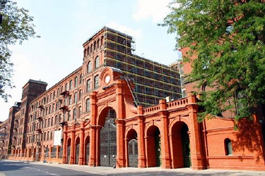
Old factories in Poland are being transformed into stylish retail and entertainment centers
 |
One exemplary preservation of old architecture is located in Łódź, about 130 kilometers west of Warsaw. In the city nicknamed the Polish Manchester, textile machines no longer hum. On the territory of the former empire of Jewish industrialist Poznański, the Manufaktura commercial and entertainment center was created. Once there was one of the largest textile factories in Europe, complete with its own railway, fire station, and houses for workers.
Production continued until 1997, when the entire textile industry in Poland went bankrupt. The factory, located on 27 hectares, was forgotten. Polish architects, along with colleagues from London and Lyon, devised a new use for it. It was necessary to restore 50,000 square meters.
Manufaktura opened in 2006. It immediately attracted the attention of residents and experts. The complex features shops, restaurants, fitness centers, cinemas, and galleries. The disco is housed in a former Art Nouveau heating plant from 1912, while a four-star hotel was created in the spinning mill.
Western Poland's Poznań is also drawing tourists to an old brewery. Designers gave the 19th-century building a new face. The red-brick walls were preserved, and experts restored the fireplaces; in the midst of the boutiques are brewing kettles. The center of trade, art, and business, as it is officially called, has been awarded multiple times in international architectural competitions.
Recognition was also received in eastern Poland's Białystok, where the modern Alfa shopping center was built on the foundations of two old buildings. One of them was a wool and silk factory founded in 1883 by Eugeniusz Becker. "Products from Białystok were valued by both Russians and Germans during the war," explained Izabela Lysková from the city office to ČTK. The second monument is a stable from 1911, the remains of which can be seen from inside the complex. It houses a café, and next to it is a climbing wall.
The center, opened last year, received the CIJ award, given by the prestigious magazine Construction&Investment Journal in the category of best investment in commercial centers.
Focus Park in Zielona Góra, near the Polish-German border, also aims to attract the attention of shopping tourists. "The wool factory that employed 3,000 people went bankrupt in 1999," clarified Jarosław Wnorowski from the Zielona Góra information center to ČTK. The complex of empty buildings represented interesting industrial architecture. Engineers took advantage of this and breathed new life into the area. In the fall, people returned to the building, this time not for machinery but for tables in restaurants or in cinemas.
The connection of the new and the old is appreciated by architects and praised by mayors, who sometimes do not know what to do with the huge industrial complexes that are sitting empty. And in the end, residents are satisfied as well, as they can spend long winter evenings in the commercial and entertainment centers.
The English translation is powered by AI tool. Switch to Czech to view the original text source.
0 comments
add comment












